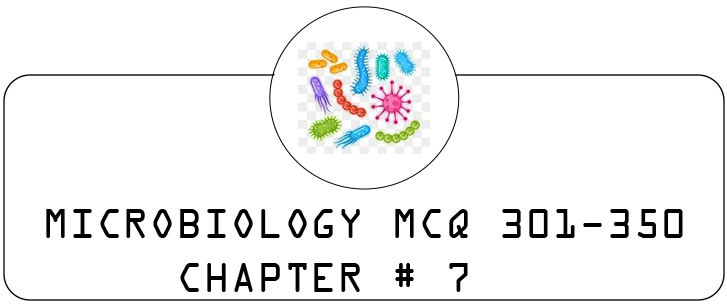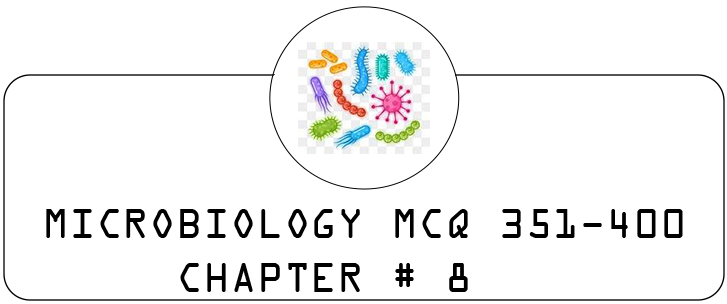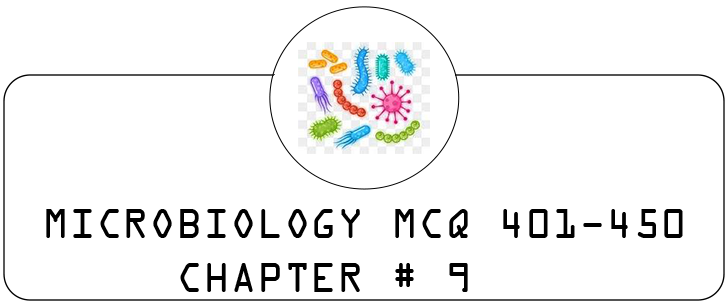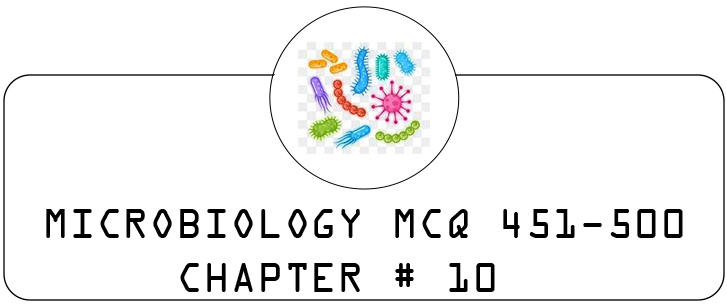301. _____ fungi that can exist as a mold as well as yeast.
A. Hyphae
B. Tinea pedis
C. Dimorphic ✅
D. Spore forming
A. Hyphae
B. Tinea pedis
C. Dimorphic ✅
D. Spore forming
302. The viruses that attack bacteria are:
A. Bacteriophages ✅
B. Bacterial viruses
C. Bacterial pathogens
D. Virions
A. Bacteriophages ✅
B. Bacterial viruses
C. Bacterial pathogens
D. Virions
303. Fungal hyphae may be:
A. Septate
B. Non-septate
C. Branched
D. All of these ✅
A. Septate
B. Non-septate
C. Branched
D. All of these ✅
304. Where are target cells of diphtherotoxin located?
A. The skin
B. The skeletal muscles
C. The lungs
D. The heart and nervous system ✅
A. The skin
B. The skeletal muscles
C. The lungs
D. The heart and nervous system ✅
305. Fusion of nuclei in fungi is:
A. Karyogamy ✅
B. Progamy
C. Microgamy
D. Pregamy
A. Karyogamy ✅
B. Progamy
C. Microgamy
D. Pregamy
306. Which of the following is a purine?
A. Adenine ✅
B. Thymine
C. Uracil
D. Cytosine
A. Adenine ✅
B. Thymine
C. Uracil
D. Cytosine
307. Substitutions that prematurely stop synthesis of protein, by generating a stop codon, are called:
A. Missense mutation
B. Nonsense mutation ✅
C. Frameshift mutation
D. Alternation
A. Missense mutation
B. Nonsense mutation ✅
C. Frameshift mutation
D. Alternation
308. What type of vaccine is the anthrax vaccine?
A. Attenuated bacteria
B. Toxoid
C. Killed whole bacterial cells ✅
D. Recombinant
A. Attenuated bacteria
B. Toxoid
C. Killed whole bacterial cells ✅
D. Recombinant
309. Tuberculosis is spread by:
A. Contaminated fomites
B. Food
C. Respiratory droplets ✅
D. Vectors
A. Contaminated fomites
B. Food
C. Respiratory droplets ✅
D. Vectors
310. What causes the major symptoms of tetanus?
A. Production of tetanospasmin ✅
B. Multiplication of organisms at the site of infection
C. Production of botulin toxin
D. Superinfection due to antibiotic therapy
A. Production of tetanospasmin ✅
B. Multiplication of organisms at the site of infection
C. Production of botulin toxin
D. Superinfection due to antibiotic therapy
311. Clostridium difficile is associated with:
A. Myonecrosis
B. Food poisoning
C. Antibiotic-induced colitis ✅
D. Gas gangrene
A. Myonecrosis
B. Food poisoning
C. Antibiotic-induced colitis ✅
D. Gas gangrene
312. Which of the following can swarm on a plate, making it difficult to distinguish colonies?
A. E. coli
B. Shigella dysenteriae
C. Salmonella typhi
D. Proteus vulgaris ✅
A. E. coli
B. Shigella dysenteriae
C. Salmonella typhi
D. Proteus vulgaris ✅
313. Only one of the followings is characteristic of B-cells but not T-cells:
A. Class I MHC
B. CD3
C. Polyclonal activation by concanavalin A
D. Surface immunoglobulin ✅
A. Class I MHC
B. CD3
C. Polyclonal activation by concanavalin A
D. Surface immunoglobulin ✅
314. Robert Koch developed his postulates using:
A. Bacillus cereus
B. Clostridium tetani
C. Bacillus anthracis ✅
D. Staphylococcus aureus
A. Bacillus cereus
B. Clostridium tetani
C. Bacillus anthracis ✅
D. Staphylococcus aureus
315. How are most cases of listeriosis transmitted?
A. Insect vectors
B. Respiratory secretions
C. Transplacental
D. Contaminated food ✅
A. Insect vectors
B. Respiratory secretions
C. Transplacental
D. Contaminated food ✅
316. Which infectious agent is an obligate parasite?
A. Mycobacterium tuberculosis
B. Corynebacterium diphtheriae
C. Mycobacterium leprae ✅
D. Clostridium difficile
A. Mycobacterium tuberculosis
B. Corynebacterium diphtheriae
C. Mycobacterium leprae ✅
D. Clostridium difficile
317. Which infection can be considered as zoonosis?
A. Anthrax ✅
B. Gas gangrene
C. Diphtheria
D. Leprosy
A. Anthrax ✅
B. Gas gangrene
C. Diphtheria
D. Leprosy
318. Bacterial cells divide by:
A. Budding
B. Binary fission ✅
C. Spores
D. Sexual reproduction
A. Budding
B. Binary fission ✅
C. Spores
D. Sexual reproduction
319. A classic symptom of pertussis is:
A. Diarrhea
B. Paroxysmal coughing ✅
C. Convulsions
D. Headache
A. Diarrhea
B. Paroxysmal coughing ✅
C. Convulsions
D. Headache
320. Complications of typhoid fever are:
A. Neurological damage
B. Intestinal perforation ✅
C. Liver abscesses ✅
D. Both “B” and “C”
A. Neurological damage
B. Intestinal perforation ✅
C. Liver abscesses ✅
D. Both “B” and “C”
321. How are Leptospira species transmitted from their animal reservoirs to humans?
A. Animal bites
B. Arthropod vectors
C. Contact with urine from an infected animal ✅
D. Inhalation
A. Animal bites
B. Arthropod vectors
C. Contact with urine from an infected animal ✅
D. Inhalation
322. Coliforms are used as indicator organisms of sewage pollution because ________.
A. They are pathogens
B. They ferment lactose ✅
C. They are abundant in human intestines ✅
D. All of the above
A. They are pathogens
B. They ferment lactose ✅
C. They are abundant in human intestines ✅
D. All of the above
323. A patient with nausea, vomiting, and diarrhea within 5 hours after eating most likely has:
A. Shigellosis
B. E. coli gastroenteritis
C. Salmonellosis
D. Intoxication ✅
A. Shigellosis
B. E. coli gastroenteritis
C. Salmonellosis
D. Intoxication ✅
324. The bubo of bubonic plague is a/an:
A. Ulcer where the flea bite occurred
B. Granuloma in the skin
C. Enlarged lymph node ✅
D. Infected sebaceous gland
A. Ulcer where the flea bite occurred
B. Granuloma in the skin
C. Enlarged lymph node ✅
D. Infected sebaceous gland
325. Escherichia coli displays which antigens?
A. Capsular
B. Flagellar
C. Somatic
D. All of these ✅
A. Capsular
B. Flagellar
C. Somatic
D. All of these ✅
326. The causative agent of gas gangrene is:
A. Clostridium perfringens ✅
B. Bacillus cereus
C. Staphylococcus aureus
D. Streptococcus pneumoniae
A. Clostridium perfringens ✅
B. Bacillus cereus
C. Staphylococcus aureus
D. Streptococcus pneumoniae
327. Which of the following is a common mode of transmission for the hepatitis A virus?
A. Airborne droplets
B. Fecal-oral route ✅
C. Blood transfusion
D. Sexual contact
A. Airborne droplets
B. Fecal-oral route ✅
C. Blood transfusion
D. Sexual contact
328. Which type of media is used to cultivate fastidious organisms?
A. General purpose media
B. Enrichment media ✅
C. Selective media
D. Differential media
A. General purpose media
B. Enrichment media ✅
C. Selective media
D. Differential media
329. Which of the following is a common method for diagnosing tuberculosis?
A. Blood culture
B. Sputum culture ✅
C. Urine culture
D. Stool culture
A. Blood culture
B. Sputum culture ✅
C. Urine culture
D. Stool culture
330. The Gram-negative bacterium responsible for cholera is:
A. Escherichia coli
B. Vibrio cholerae ✅
C. Salmonella typhi
D. Campylobacter jejuni
A. Escherichia coli
B. Vibrio cholerae ✅
C. Salmonella typhi
D. Campylobacter jejuni
331. The principal virulence factor of Streptococcus pneumoniae is:
A. Endotoxin
B. Capsule ✅
C. Exotoxin
D. Pili
A. Endotoxin
B. Capsule ✅
C. Exotoxin
D. Pili
332. Which of the following pathogens is known to cause gastroenteritis?
A. Staphylococcus aureus
B. Clostridium difficile
C. Salmonella ✅
D. All of these
A. Staphylococcus aureus
B. Clostridium difficile
C. Salmonella ✅
D. All of these
333. The main symptom of diphtheria is:
A. Skin rash
B. Sore throat ✅
C. Cough
D. Fever
A. Skin rash
B. Sore throat ✅
C. Cough
D. Fever
334. The body’s first line of defense against pathogens includes:
A. Skin ✅
B. Inflammation
C. Antibodies
D. Phagocytes
A. Skin ✅
B. Inflammation
C. Antibodies
D. Phagocytes
335. The following are characteristic of viruses EXCEPT:
A. They are cellular
B. They can mutate
C. They reproduce only in host cells ✅
D. They contain genetic material
A. They are cellular
B. They can mutate
C. They reproduce only in host cells ✅
D. They contain genetic material
336. The definitive host for Toxoplasma gondii is:
A. Cat ✅
B. Dog
C. Sheep
D. Human
A. Cat ✅
B. Dog
C. Sheep
D. Human
337. Which of the following vaccines is a live attenuated vaccine?
A. Diphtheria
B. Measles ✅
C. Influenza
D. Tetanus
A. Diphtheria
B. Measles ✅
C. Influenza
D. Tetanus
338. Which organism is most commonly responsible for urinary tract infections?
A. Escherichia coli ✅
B. Staphylococcus saprophyticus
C. Klebsiella pneumoniae
D. Enterococcus faecalis
A. Escherichia coli ✅
B. Staphylococcus saprophyticus
C. Klebsiella pneumoniae
D. Enterococcus faecalis
339. The minimum temperature for the growth of most pathogenic bacteria is:
A. 0°C
B. 15°C
C. 20°C
D. 30°C ✅
A. 0°C
B. 15°C
C. 20°C
D. 30°C ✅
340. The typical shape of cocci bacteria is:
A. Rod
B. Spiral
C. Spherical ✅
D. Irregular
A. Rod
B. Spiral
C. Spherical ✅
D. Irregular
341. Which type of immunity is characterized by the presence of memory cells?
A. Innate immunity
B. Adaptive immunity ✅
C. Passive immunity
D. Non-specific immunity
A. Innate immunity
B. Adaptive immunity ✅
C. Passive immunity
D. Non-specific immunity
342. The component of the immune system that can distinguish self from non-self is:
A. Antibodies
B. T-cells ✅
C. B-cells
D. Macrophages
A. Antibodies
B. T-cells ✅
C. B-cells
D. Macrophages
343. Which of the following is a typical method of sterilization?
A. Autoclaving ✅
B. Disinfecting
C. Hand washing
D. Cleaning
A. Autoclaving ✅
B. Disinfecting
C. Hand washing
D. Cleaning
344. Which of the following is used to prevent the spread of viral infections?
A. Vaccination ✅
B. Antiseptics
C. Antibiotics
D. Antivirals
A. Vaccination ✅
B. Antiseptics
C. Antibiotics
D. Antivirals
345. The primary function of the spleen in the immune system is:
A. Production of antibodies
B. Filtration of blood ✅
C. Production of red blood cells
D. Storage of platelets
A. Production of antibodies
B. Filtration of blood ✅
C. Production of red blood cells
D. Storage of platelets
346. The primary virulence factor of Staphylococcus aureus is:
A. Coagulase ✅
B. Exotoxin
C. Enterotoxin
D. Hemolysin
A. Coagulase ✅
B. Exotoxin
C. Enterotoxin
D. Hemolysin
347. The main cause of tuberculosis is:
A. Mycobacterium leprae
B. Mycobacterium tuberculosis ✅
C. Mycobacterium avium
D. Mycobacterium bovis
A. Mycobacterium leprae
B. Mycobacterium tuberculosis ✅
C. Mycobacterium avium
D. Mycobacterium bovis
348. What is the main function of lysozyme?
A. To inhibit viral replication
B. To digest bacterial cell walls ✅
C. To promote inflammation
D. To produce antibodies
A. To inhibit viral replication
B. To digest bacterial cell walls ✅
C. To promote inflammation
D. To produce antibodies
349. Which of the following is a characteristic of the innate immune system?
A. Memory
B. Specificity
C. Non-specificity ✅
D. Adaptability
A. Memory
B. Specificity
C. Non-specificity ✅
D. Adaptability
350. Which organism is known for causing the common cold?
A. Bacteria
B. Virus ✅
C. Fungus
D. Parasite
A. Bacteria
B. Virus ✅
C. Fungus
D. Parasite





